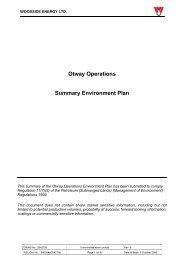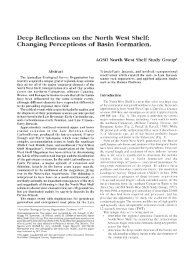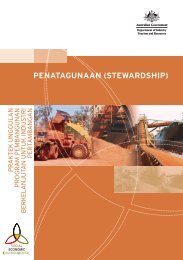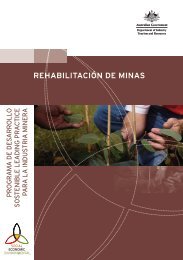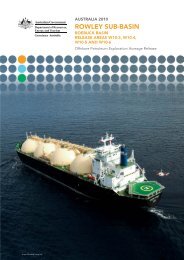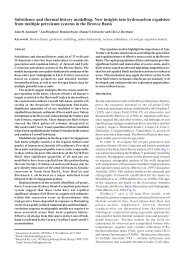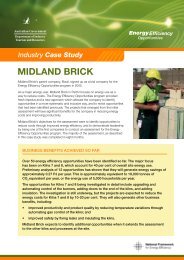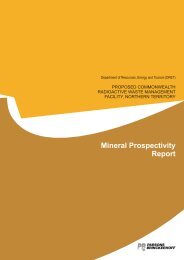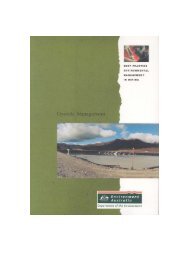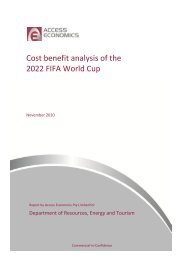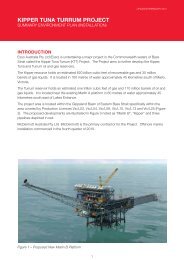A guide to leading practice sustainable development in mining
A guide to leading practice sustainable development in mining
A guide to leading practice sustainable development in mining
Create successful ePaper yourself
Turn your PDF publications into a flip-book with our unique Google optimized e-Paper software.
The Hs<strong>in</strong>-Chen Shan quarry terra<strong>in</strong> is very steep ris<strong>in</strong>g from SL120m <strong>to</strong><br />
SL740m with<strong>in</strong> only 1000m horizontal distance. In accordance <strong>to</strong> this unique<br />
<strong>to</strong>pography, A.C.C. <strong>in</strong>troduced a rapid shaft transport<strong>in</strong>g system from Japan<br />
<strong>in</strong> 1978, the first quarry <strong>to</strong> utilize this type of shaft system <strong>in</strong> Taiwan m<strong>in</strong><strong>in</strong>g<br />
his<strong>to</strong>ry. With this successful experience, the quarry constructed the second<br />
300m depth vertical shaft <strong>to</strong> match cement plant expansion project <strong>in</strong> 1988.<br />
Crushed limes<strong>to</strong>ne is directly dumped <strong>in</strong><strong>to</strong> the vertical shaft, <strong>to</strong> elim<strong>in</strong>ate<br />
the need of almost 5 kilometres of haul<strong>in</strong>g by trucks. In addition <strong>to</strong> the<br />
transportation sav<strong>in</strong>g, the shaft system also has the advantage of reduc<strong>in</strong>g<br />
the dust pollution from truck fleets and preserv<strong>in</strong>g the orig<strong>in</strong>al landscape<br />
amenity.<br />
This system reduces the area of exposed benches markedly. The upper<br />
excavated out benches (the f<strong>in</strong>al berms) are replanted with trees immediately<br />
after m<strong>in</strong><strong>in</strong>g. The comb<strong>in</strong>ation of an underground and sealed convey<strong>in</strong>g<br />
system reduces dust and noise over the length of 1.3 km convey<strong>in</strong>g system<br />
from quarry <strong>to</strong> cement plant.<br />
Evidence of recolonisation of several species <strong>in</strong>clud<strong>in</strong>g cobra and other<br />
snakes, boars and monkeys back <strong>to</strong> the once quarried area, illustrates the<br />
success of this reclamation method.<br />
The quarry has m<strong>in</strong>ed out 130 million <strong>to</strong>nnes of limes<strong>to</strong>ne s<strong>in</strong>ce 1974. After<br />
m<strong>in</strong><strong>in</strong>g <strong>to</strong> the pit bot<strong>to</strong>m, i.e., 120mSL, there will be a 30~40 hectares open<br />
ground for public use. Some visi<strong>to</strong>rs have expressed the view that the<br />
reclaimed f<strong>in</strong>al benches are even better look<strong>in</strong>g than the orig<strong>in</strong>al land surface.<br />
The reclaimed benches <strong>in</strong> 1998<br />
(Pho<strong>to</strong> by ACC)<br />
Figure 5.28 - Comparison of benches ten years apart<br />
* contributed by: Lawrence Hu, ACC<br />
The m<strong>in</strong>ed-out benches before<br />
reclamation <strong>in</strong> 1988 (Pho<strong>to</strong> by ACC)<br />
A GUIDE TO LEADING PRACTICE SUSTAINABLE DEVELOPMENT IN MINING 165






